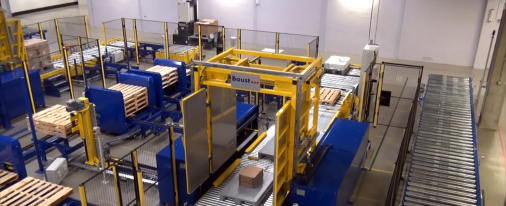Egemin Automation offers automatic pallet exchange system solution
Product safety is essential, both in the food industry and in the pharmaceutical market. As a result of recent troubles created by items being contaminated by fumigants on pallets, several pharmaceutical firms have forbidden using wood pallets in their manufacturing. They prescribe plastic pallets within the production location, but transportation of raw materials from suppliers and distribution to end clients happens on wood pallets. Egemin Automation offers the solution to this with its automatic pallet exchange systems, an efficient and much less time-consuming choice for manual exchanges.

Plastic pallets, a good alternative – ISPM 15
Photo by Egemin Automation
ISPM 15
International regulations have actually been laid down for the transport of pharmaceutical items and food on wood pallets in the international specification ISPM15. ISPM15 (International Phytosanitary Measure 15) was drawn up by the International Plant Defense Convention (part of the FAO, Food and Agriculture Company of the United Nations) in March 2002 and upgraded in 2006.
ISPM15 stipulates that pallets must be dealt with at a high temperature or with an anti-bacterial in order to eliminate parasites etc. in the wood. However, anti-bacterials such as methyl bromide could taint the pallets and are prohibited as a fumigant for timber product packaging in EU Member States.
Plastic pallets, a good alternative
The alternative is pallets made from plastic. These do not rust and are resistant to moisture, grease and most acids and chemicals. They are easy to clean, have smooth edges and are impervious to vermin. This makes them hygienic and ideal for use in the production of food, beverages and pharmaceutical products. But raw materials often arrive at the factory on wooden pallets and the shipment of finished products to end customers, such as distribution centres and retailers, usually takes place – for cost reasons – on wooden pallets.
Automatic pallet changes increases efficiency
The internal prohibition by companies on the use of wooden pallets in manufacturing therefore requires a new approach to the flow of goods from raw materials, semi-finished and finished products. To ensure this, products need to be transferred somewhere between production and distribution. Loading pallets manually is a very time-consuming and costly method. Automatic pallet exchange systems, if desired with automated loading and unloading, offer a better solution economically.
In reality, therefore, this involves two transfer installations: a wood-plastic transfer machine for the inbound flow (supply from warehouse to production) and a plastic-wood transfer machine for the outbound flow (from production to the distribution warehouse). In addition, buffer locations are provided for stacks of plastic and wooden pallets, and a central transfer car to bring the plastic and wooden pallets to the buffer locations, and back to the transfer machines.
The installation is also equipped with infeed and outfeed conveyors to bring full pallets to the transfer machines and to remove full pallets that have been switched. Transport between the pallet exchange system and the production area, the distribution area and the automated warehouse can be flexibly automated using Automated Guided Vehicles. Automatic labelling of the pallet for tracking & tracing purposes is also possible.
A unique solution
The unique feature of Egemin’s solution is that the pallet exchange system enables 5 different types of pallets to be handled. If desired by the customer redundancy features can also be integrated, so that the outbound transfer machine can also be used for the incoming flow of pallets. This ensures that the flow from supply to production is always guaranteed.
For further information, please visit: www.egemin.com
News Categories
- » NEWS HOME
- » Automation & Robotics
- » Industry 4.0
- » Material Handling
- » Sensors
- » Quality & Testing
- » Machine Vision
- » Laser & Optics
- » Metalworking
- » Motion Control & Drives
- » Hydraulics & Pneumatics
- » Process Industry
- » Renewable Energy
- » Agriculture
- » Home & Office Furniture
- » Environmental Tech



